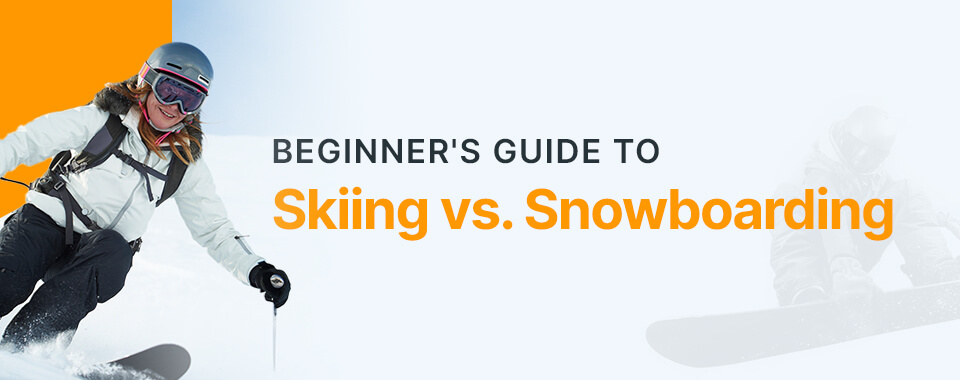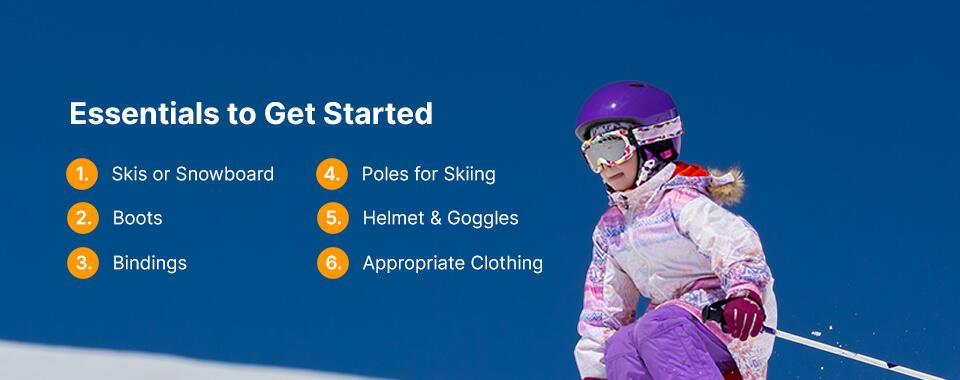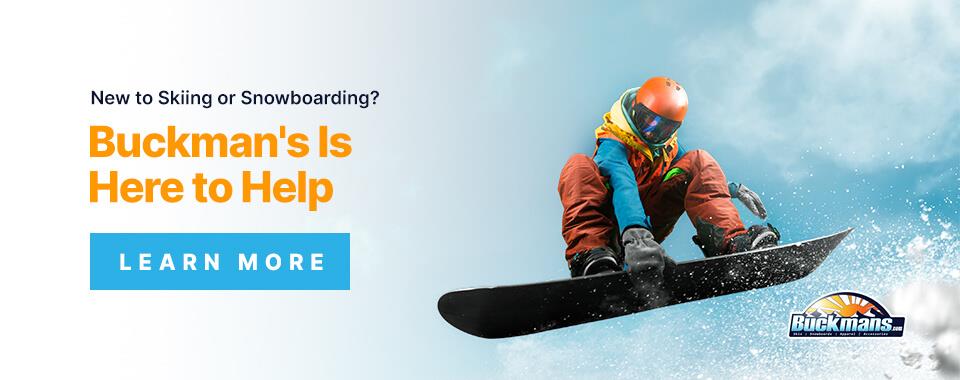 Beginner's Guide to Skiing or Snowboarding
Beginner's Guide to Skiing or Snowboarding
Beginner's Guide to Skiing vs. Snowboarding
Posted
by
Matt Gahman
on Wednesday, March 16, 2022
Are you interested in skiing or snowboarding? Snow sports are fun for the whole family — but which one is the best fit for you? Snowboarding and skiing offer unique challenges and exciting thrills, but they come with a few notable differences.
Skiing vs. Snowboarding — How Are They Similar?
Whether you're learning to snowboard or ski for the first time, both sports take consistency and practice to build up your skillset and gain confidence on the slopes. Despite their differences, the two sports have a few things in common:
They're a Great Form of Exercise
Staying active and getting outdoors is amazing for physical and mental health, especially during cold winter months. Snowboarding and skiing get your blood pumping and coursing through your system, which is important for cardiovascular health.
Winter sports also help you work off winter weight gain. A 150-pound person burns about 480 calories in one snowboarding session, while a 190-pound person burns about 700 calories after only one hour of cross-country skiing.
These exercises also help build muscle and bone strength, especially in your core, legs, arms and glutes. You can work on your agility, flexibility, endurance and balance while staying mentally sharp and soaking up sunshine rich in vitamin D to bolster your immune system and mental health.
Many Destinations Have Trails for Both
Many ski areas, lodges and resorts have designated areas for both skiing and snowboarding, even if both sports aren't explicitly listed in the name. Therefore, you can partake in either on just about any place that offers access to the slopes.
While it's rare for skiing locations to only offer skiing, always check with the facility's guidelines and rules of conduct before planning your trip.
You Choose How to Approach the Sport
Whether skiing or snowboarding calls to you more, you get to choose how you approach the sport. Maybe you're looking for a new wintertime hobby to stay fit and get more sunshine, or you come from a long line of competitive winter athletes. Maybe you're just interested in trying something new on your upcoming vacation and need a good story to tell your friends when you get home.
Whatever your reason for trying a new sport, snowboarding and skiing are both worth trying for beginners and experienced athletes.
The Differences Between Skiing and Snowboarding
Now that you know what they have in common, let's jump into what makes these two snow sports different from each other.
Posture and Position
Snowboarders ride with a straight back, slightly bent, relaxed knees and hips aligned over their knees and feet while looking directly ahead. They keep their arms relaxed at the side with general ease in the body to support more flexible movement.
Each snowboard has a toe side and heel side — the long sides of the board — and riders choose which leading foot is most comfortable for them and lead with that leg, sometimes angling feet and bindings slightly. “Natural” snowboarders lead with their left foot, while “goofy” riders lead with their right. There is no correct way to lead — it's whatever feels best for your body type.
Skiers have more movement options since they're attached to two separate skis instead of a single board. The way they angle their bodies depends on which direction they're moving and how steep their slope is. They'll typically have a ski pole in each hand while centering their weight in the middle of the skis.
Skiers shift their weight over their boots to move down while looking ahead, leaning as the slopes flatten. Because they can lift each ski and knee separately, they can hinge or create angles as needed.
Terrain and Trail Types
Common types of skiing include downhill skiing, cross-country skiing and alpine touring (AT). Trails might be on groomed slopes, quick-turn moguls or powder at a terrain park.
Snowboarders might go all-mountain, freestyle, freeride or powder boarding. While they can handle flat terrain, they don't have poles as skiers do, so they must approach level ground with speed and momentum. Moguls are especially tricky for beginners.
Beginner snowboarders and skiers should start on simple slopes, like the bunny slopes, and avoid off-trail treks until they have more experience.
Ski Lift Difficulty
Skiers get on a ski lift by holding their poles in one hand and using the other hand to sit in the chair. Snowboarders have both hands free for easier boarding.
The real challenge comes to exiting the ski chair. All skiers have to do is hold their poles and stand when the lift slopes, keeping their poles pointed toward the direction they want to move. Snowboarders have to angle their back foot in a way that provides leverage and stability so they can maintain balance as they slide from the lift chair.
Both skiers and snowboarders must keep their equipment pointed straight and use the snow's natural friction to move forward. The more relaxed you are, the easier time you'll have — but it takes practice.
Control and Navigation
Skiing offers more control than snowboarding because you have options for stopping and moving, such as ski poles and separate ski boards. Skiers turn in one of two ways — pivoting their bodies to slow and turn or tipping their bodies by leaning skis on their edge and focusing their body weight in the middle to make it around curves. Though beginners might be tempted to rely on ski poles for balance, they're there to help develop a rhythm and should be planted firmly in the snow during movements.
Snowboarders move their heads — not their entire bodies — in the direction they want to move. Two turning types include skidding for slower, simpler turns, which helps the board glide over the snow, and carved turns, which dig the board's edges into the snow and leave behind a smooth line on the slopes. Snowboarders also have the option to take toeside, also called frontside, turns and heelside, or backside, turns.
Physical Strain
Any type of snow sport is physically demanding, which is why it's important to start slow and work with a professional if you can. You can ward off any morning-after soreness by stretching your muscles and participating in plenty of training before hitting the slopes for the first time.
Snowboarding tends to be easier on the knees than skiing, but investing in quality equipment that fits your body well can help protect you from excessive impact or strain no matter which sport you prefer.
Is Skiing Easier to Learn Than Snowboarding?
Many beginners consider skiing easier to learn than snowboarding, but it depends on your previous athletic experience and what you consider “easy.”
If you value having maximum control and more hands-on navigation, skiing should be simpler for you than snowboarding. Ski lifts are also easier when skiing. You can assume a more natural, front-facing position when skiing, and two separate skis offer better control over movement.
That said, skiing is harder to advance in than snowboarding. Once you learn the basics of snowboarding stance and movement, you can easily apply those same principles to learn more tricks, turns and navigation tricks.
How to Get Started Skiing

Some skiers compare skiing to rollerblading, but everyone's experience is different. Beginning skiers should not start learning with poles. Most instructors will have you leave them behind until you build core foundations without relying on them for balance.
Be careful not to lock your knees, and keep as much bend and movement in your legs as you can. Aim for a “pizza” shape, with your skis angled slightly inward, and keep your head pointing forward and not looking down.
Essential ski equipment includes:
- Skis
- Ski poles
- Ski boots and bindings
- A ski helmet
- Layered clothes
- Goggles
- Ski care equipment
How to Get Started Snowboarding
Snowboarding can be compared to surfing, but with slightly more predictable terrain and more obstacles to maneuver. The most important thing to remember as a new boarder is to ride across the slopes, not down them. This strategy will help you keep control of the direction you're moving.
Don't be afraid of speed. The moment you start fighting against natural momentum and gravity is when blunders are more likely to happen. Lean into the speed and practice confidence in your navigation.
Essential snowboarding equipment includes:
- A snowboard
- Snowboard boots and bindings
- A snowboard helmet
- Goggles
- Layered clothes
- Snowboard care equipment

Categories:
Ski & Snowboarding Tips